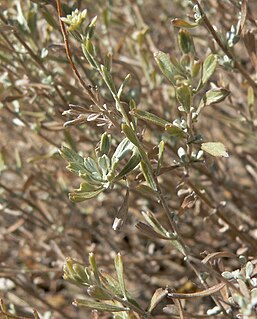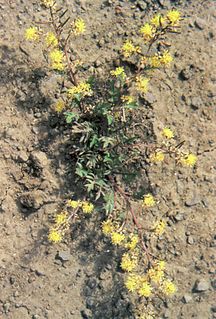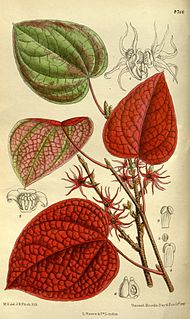In biological classification, a subfamily is an auxiliary (intermediate) taxonomic rank, next below family but more inclusive than genus. Standard nomenclature rules end subfamily botanical names with "-oideae", and zoological names with "-inae".

Euphorbia albomarginata, whitemargin sandmat or rattlesnake weed, is a small low-growing annual, in the spurge family native to desert, chaparral, and grassland habitats of southwestern North America, from southern and central California to Northern Mexico and Louisiana.

Eriogonum fasciculatum is a species of wild buckwheat known by the common names California buckwheat and eastern Mojave buckwheat.

Lithospermum incisum is a species of flowering plant in the borage family known by several common names, including narrowleaf stoneseed, fringed gromwell, narrowleaf puccoon, and plains stoneseed. It is native to much of central Canada and the United States, where it is known from many types of habitat. It is a hairy perennial herb growing from a taproot and woody caudex. It produces a cluster of stems up to about 30 centimeters long. The stems are lined with narrow, pointed leaves up to 6 centimeters long. The slender, trumpet-shaped flowers are pale to bright yellow or gold, and may approach 4 centimeters long. The corolla face is 1 to 2 centimeters wide, its lobes sometimes ruffled.

Cycloloma is a monotypic genus which contains the sole species Cycloloma atriplicifolium, which is known by the common names winged pigweed, tumble ringwing, plains tumbleweed, and tumble-weed. This plant is native to central North America, but it is spreading and has been occasionally reported in far-flung areas from California to Maine to the Canadian prairie. It is considered an introduced species outside of central North America. This is a bushy annual herb forming a rounded pale green clump which may exceed half a meter in height. It is very intricately branched, with toothed leaves occurring near the base. The spreading stems bear widely spaced flowers are small immature fruits fringed with a nearly transparent membranous wing. In autumn, the plant forms a tumbleweed. The fruit is a utricle about 2 millimeters long containing a single seed.

Erechtites is a genus of flowering plants in the daisy family known commonly as fireweeds or burnweeds. They are native to the Americas and Australia, but some species are widely distributed weeds.

Euphorbia spathulata is a species of spurge known by the common names warty spurge and roughpod spurge.

Krascheninnikovia lanata is a species of flowering plant in the family Amaranthaceae, known by the common name winterfat. It is native to much of western North America: from central Western Canada; through the Western United States; to northern Mexico.

Acourtia microcephala is a species of flowering plant in the daisy family known by the common name sacapellote. It is native to southern California and Baja California, where it grows in woodland and chaparral, especially in the coastal mountain ranges.

Euphorbia polycarpa is a species of spurge known by the common name smallseed sandmat. It is native to the southwestern United States and northern Mexico, especially the deserts and other dry, sandy areas. This is a perennial herb producing stems that trail along the ground to form a clump or mat, sometimes growing somewhat upright. The leaves are each under a centimeter long. They are round or oval-shaped and have triangular stipules at the bases. What looks like a single flower is actually an inflorescence of many staminate (male) flowers united around a single central pistillate (female) flower. Bracts surrounding the flower unit are white and petal-like. The fruit is a thin spherical capsule less than 2 millimeters wide layered over a seed.

Antennaria rosea is a North American species of flowering plant in the daisy family known by the common name rosy pussytoes. Other common names include cat's foot and mountain everlasting. It is widespread across much of Canada including all three Arctic territories, as well as Greenland, the western and north-central United States, and the Mexican State of Baja California.

Arenaria congesta is a species of flowering plant in the family Caryophyllaceae known by the common name ballhead sandwort. It is native to western North America from central Canada to the American southwest.

Artemisia bigelovii is a North American species of sagebrush known by the common name Bigelow sagebrush or flat sagebrush. It grows in the deserts of the southwestern United States.

Linum puberulum is a species of flax known by the common name plains flax. It is native to the western and midwestern United States from California to Nebraska to Texas, where it grows in dry, open habitat including desert, semi-desert, hills and low mountains. It is a downy-haired perennial herb producing an erect, branching stem lined with glandular linear leaves up to about 1 centimeter long. The inflorescence is a wide open cyme of golden yellow to yellow-orange flowers each with five petals 1 to 1.5 centimeters in length. The fruit is a capsule about 4 millimeters wide.

Phoradendron juniperinum is a species of flowering plant in the sandalwood family known by the common name juniper mistletoe. It is native to the southwestern United States and northern Mexico, where it grows in various types of woodland habitat. It has been reported from California, Nevada, Arizona, New Mexico, Oregon, Utah, Texas, Chihuahua and Sonora.

Rorippa sinuata is a species of flowering plant in the family Brassicaceae known by the common name spreading yellowcress. It is native to North America, including most all of the western and central United States, where it grows in many types of moist and wet habitat, such as lakeshores and riverbanks, meadows, and mudflats. It is a perennial herb producing spreading stems up to 40 or 50 centimeters long. It is densely hairy, the hairs rounded like sacs or vesicles. The leaves are up to 8 centimeters long and have blades are deeply toothed, lobed, or divided into smaller leaflets. The inflorescence is an elongated raceme occupying the top portion of the stem containing many tiny yellow flowers just a few millimeters long. The fruit is a curved silique which is variable in size and shape but generally contains many minute seeds.

Disanthus cercidifolius is a species of flowering plant in the family Hamamelidaceae. It is native to woodland habitats in China and Japan.
The Kew Rule was used by some authors to determine the application of synonymous names in botanical nomenclature up to about 1906, but was and still is contrary to codes of botanical nomenclature including the International Code of Nomenclature for algae, fungi, and plants. Index Kewensis, a publication that aimed to list all botanical names for seed plants at the ranks of species and genus, used the Kew Rule until its Supplement IV was published in 1913.

Nasturtium gambellii is a rare species of flowering plant in the mustard family known by the common names Gambel's yellowcress and Gambel's watercress. It is known from three or four scattered occurrences in California. It is also native to central Mexico and Guatemala. Its total U.S. population was last estimated at fewer than 300 individuals. It was federally listed in California, as an endangered species of the United States in 1993.
Callianthemoides is a genus of plants in the family Ranunculaceae, with a single species, Callianthemoides semiverticillata. Native to screes in northern Patagonia, it has divided greyish or reddish green leaves and large white or pink flowers.

















